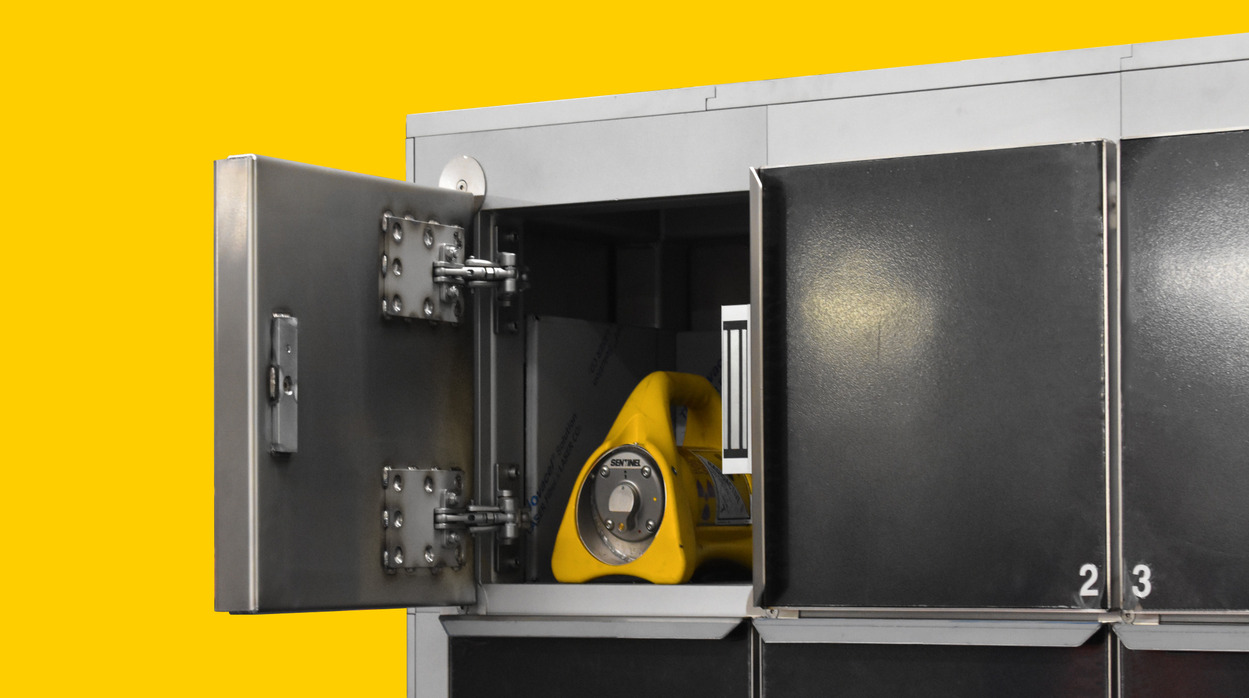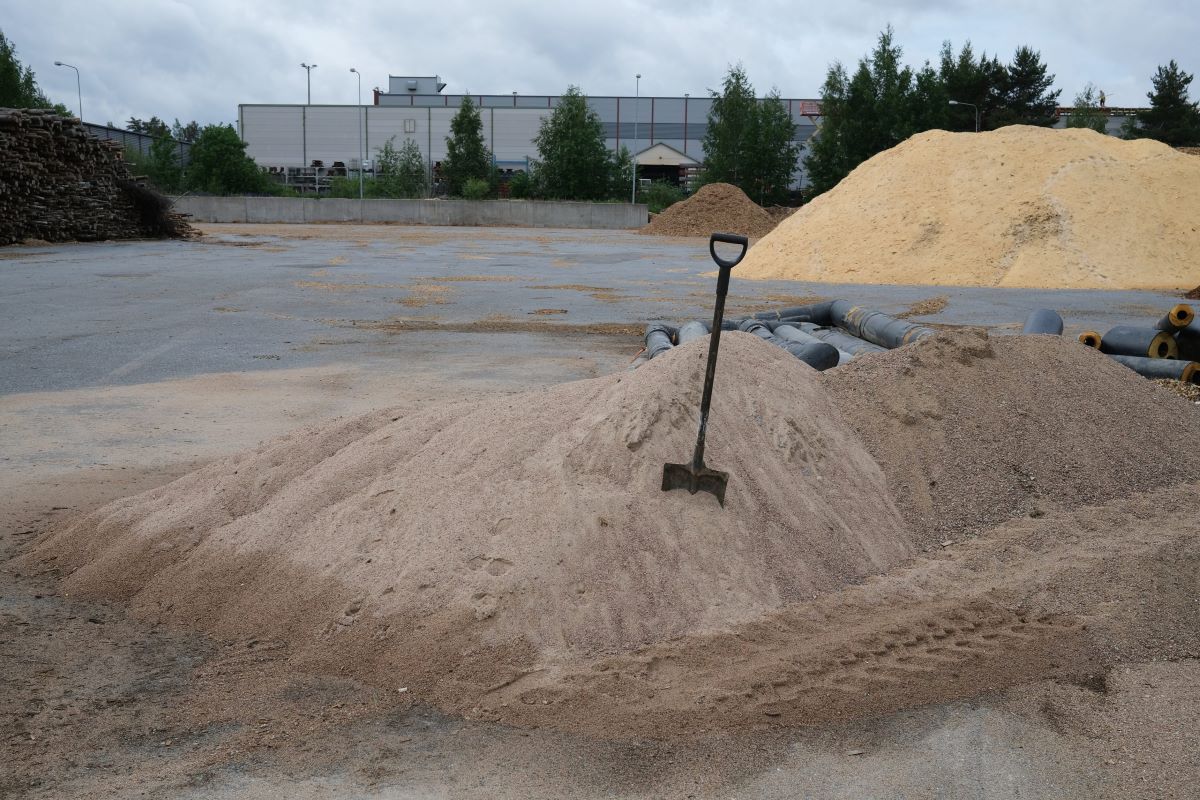

Articles
How To Store Radioactive Material
Modified: January 5, 2024
Learn how to safely store and handle radioactive materials with our informative articles. Discover the best practices and regulations for storing radioactive substances.
(Many of the links in this article redirect to a specific reviewed product. Your purchase of these products through affiliate links helps to generate commission for Storables.com, at no extra cost. Learn more)
Introduction
Radioactive materials are substances that emit radiation, either naturally or artificially. They can be found in various industries, including healthcare, research, and energy production. While these materials have numerous practical applications, they also pose inherent risks to human health and the environment. Therefore, proper storage of radioactive material is of paramount importance to ensure safety and prevent any potential hazards.
In this article, we will explore the essential guidelines and best practices for storing radioactive material. We will discuss the regulations that govern the handling and storage of these materials, as well as the different types of containers suitable for storing them. Additionally, we will delve into the design and maintenance considerations for a dedicated storage area, security measures to protect against unauthorized access, and the importance of training individuals who handle radioactive materials. Lastly, we will touch upon emergency preparedness, including protocols for handling incidents and disposing of radioactive waste.
By following the recommendations outlined in this article, organizations can maintain a safe environment for storing radioactive materials, mitigate any potential risks, and ensure compliance with regulatory requirements.
Key Takeaways:
- Proper storage of radioactive materials is crucial for safety. Adhering to regulations, training personnel, and maintaining facilities ensure responsible handling and minimize potential hazards.
- Understanding, compliance, and preparedness are key. From regulations to emergency response, prioritizing safety in storing radioactive materials is essential for protecting personnel and the environment.
Read more: How Radioactive Is Uranium Glass
Understanding Radioactive Material
Radioactive materials are substances that contain unstable atoms which undergo radioactive decay, releasing radiation in the form of particles or electromagnetic waves. This radiation can pose significant health risks to living organisms if not properly managed. Radioactive materials can be classified into three main categories: natural, artificial, and mixed waste.
Natural radioactive materials occur in the environment, such as uranium, radon, and thorium. These materials have been present since the Earth’s formation and can be found in soil, rocks, and even the air we breathe.
Artificial radioactive materials, also known as man-made or anthropogenic, are generated through human activities. These include radioactive isotopes used in medical treatments, research, and industrial processes, such as nuclear power generation and radiography.
Mixed waste refers to hazardous waste that contains both radioactive and non-radioactive components. This type of waste requires special handling and disposal methods to ensure both radioactive and non-radioactive contaminants are properly managed.
It’s essential to understand the characteristics and hazards associated with different types of radioactive materials. Radioactive decay leads to the emission of ionizing radiation, which can damage cells, DNA, and other biological structures, potentially leading to adverse health effects, including cancer and genetic mutations. The degree of risk depends on factors such as the type of radiation, dose received, and the duration of exposure.
To quantify radiation exposure, various units are used, including the becquerel (Bq) for activity, the gray (Gy) for absorbed dose, and the sievert (Sv) for equivalent dose, which takes into account the biological effects of different types of radiation. Regulatory authorities establish radiation dose limits to ensure that exposure remains within safe levels.
It is important to note that while radiation can be hazardous, it also has beneficial uses, particularly in medicine. Diagnostic imaging techniques like X-rays and nuclear medicine scans utilize controlled amounts of radiation to aid in the diagnosis and treatment of various conditions.
Overall, understanding the nature of radioactive material, its hazards, and the applicable regulations is crucial for safe handling, storage, and disposal of these substances. By adhering to proper procedures and guidelines, organizations can minimize the risks associated with radioactive materials while harnessing their beneficial applications.
Regulations and Guidelines for Storing Radioactive Material
The storage of radioactive material is highly regulated to ensure the safety of workers, the public, and the environment. Regulatory agencies, such as the Nuclear Regulatory Commission (NRC) in the United States, set forth comprehensive guidelines and requirements that must be followed when storing radioactive materials.
One of the fundamental principles of radioactive material storage is the concept of ALARA, which stands for “As Low As Reasonably Achievable.” This principle emphasizes the need to minimize radiation exposure by implementing effective controls and safety measures.
When it comes to regulations and guidelines for storing radioactive material, there are several key considerations:
- Licensing and Permitting: Depending on the type and quantity of radioactive materials, organizations may be required to obtain licenses or permits from regulatory authorities. These licenses outline specific conditions and requirements for storage facilities.
- Shielding and Containment: Radioactive materials must be stored in appropriate shielding and containment systems to minimize radiation exposure. Lead-lined containers, specialized cabinets, and concrete barriers are commonly used to provide effective radiation shielding.
- Storage Time Limits: Regulatory agencies impose time limits on the storage of radioactive materials. Facilities must adhere to these limits and adhere to strict monitoring and record-keeping practices to ensure compliance.
- Signage and Labeling: Proper signage and labeling are crucial for identifying areas where radioactive materials are stored. Clear and visible signs warn individuals of potential radiation hazards and guide them on proper safety protocols.
- Environmental Protection: Radioactive material storage facilities must have systems in place to prevent the release of radioactive substances into the environment. This includes proper waste management practices and contingency plans for spill response and clean-up.
- Radiation Monitoring and Dosimetry: Regular monitoring of radiation levels is vital to ensure that the storage facility remains within safe limits. Dosimeters and radiation detection devices are used to measure radiation levels and monitor the dose received by individuals working with radioactive materials.
It is important to note that regulations and guidelines may vary depending on the country or region. Organizations should consult with the appropriate regulatory agencies and adhere to the specific requirements applicable to their location.
By following the established regulations and guidelines for storing radioactive materials, organizations can ensure that their storage facilities are safe, compliant, and effectively protect workers and the environment from the potential hazards associated with radioactive materials.
Choosing the Right Storage Containers
When it comes to storing radioactive materials, selecting the appropriate containers is crucial to ensure safety and prevent the release of radiation. The choice of storage containers depends on factors such as the type and quantity of radioactive material, the storage duration, and regulatory requirements. Here are some key considerations when choosing the right storage containers:
- Material Compatibility: The container material must be compatible with the specific radioactive material being stored. For example, lead-lined containers are commonly used to store materials that emit gamma radiation, while plastic containers may be suitable for low-level radioactive waste.
- Shielding Capacity: The containers should provide adequate shielding to minimize radiation exposure. Lead or other dense materials are commonly used for shielding, as they effectively attenuate various types of radiation.
- Sealing and Containment: The containers should have secure lids or closures to prevent leaks or spills. This is particularly important for liquid radioactive materials that may pose a greater risk of contamination if not properly contained.
- Size and Capacity: The containers should be of an appropriate size and capacity to accommodate the quantity of radioactive material being stored. Overfilling containers can compromise their integrity and increase the risk of spillage.
- Labeling and Identification: Proper labeling and identification of storage containers are essential for easy recognition and to ensure that individuals handling the materials are aware of their contents and hazards. Clear and visible labels should include the radioactive symbol and pertinent information about the material stored.
- Transportability: If the radioactive material requires transportation, the containers should be designed for easy and safe transport. They should meet the necessary regulatory requirements for packaging and labeling during transit.
- Regulatory Compliance: It is crucial to select containers that comply with the regulatory standards and guidelines set forth by the appropriate regulatory authorities. This ensures that the containers meet the necessary safety standards for storing radioactive materials.
In addition to these considerations, organizations should regularly inspect and maintain storage containers to detect any potential signs of damage or degradation. This includes checking for corrosion, wear and tear, and ensuring that lids and closures are intact and functioning properly.
By carefully considering these factors and selecting the right storage containers, organizations can effectively mitigate the risks associated with storing radioactive materials and ensure the integrity and safety of the storage facilities.
Designing a Radioactive Material Storage Area
Designing a dedicated storage area for radioactive materials is critical to ensure the safe and secure storage of these substances. The design process should incorporate various considerations, including the layout, ventilation, access control, and emergency response preparedness. Here are key factors to consider when designing a radioactive material storage area:
- Location and Layout: The storage area should be located in a designated part of the facility, away from high-traffic areas and where unauthorized access can be restricted. The layout should allow for organized storage and easy access to containers while considering considerations such as radiation shielding and minimizing the spread of contamination.
- Shielding: Incorporate appropriate shielding materials in the design to minimize radiation exposure. Walls, floors, and ceilings can be constructed with materials such as lead, concrete, or steel to provide effective radiation attenuation. The design should consider both the type of radiation emitted by the stored materials and the required shielding thickness for the specific radioactive isotopes.
- Ventilation: Proper ventilation is crucial to maintain air quality and prevent the buildup of radioactive contaminants. The storage area should have an effective ventilation system that continuously filters and exchanges the air, eliminating any potential radioactive particles or gases.
- Access Control: Implement access control measures to restrict entry to authorized personnel only. This can include secure entrances, keycard systems, and security personnel. Additionally, video surveillance systems can monitor the storage area to ensure compliance and detect any unauthorized activities.
- Emergency Response Preparedness: The design should take into account emergency response requirements. This includes ensuring that there is sufficient space and equipment for spill response and decontamination procedures. Emergency exits and communication systems should also be incorporated into the design to facilitate a prompt and coordinated response in case of an incident.
- Signage and Labels: Clearly label the storage area with radiation warning signs and identifiers to inform individuals about potential hazards. Containers and equipment should also be labeled with the necessary information to ensure easy identification and safe handling.
- Training and Education: Provide appropriate training and education to personnel who will be working in the storage area. They should be knowledgeable about radiation safety, proper handling procedures, emergency response protocols, and the use of personal protective equipment.
It’s crucial to consult with radiation safety experts and regulatory authorities during the design process to ensure compliance with all relevant regulations and best practices. Regular monitoring and maintenance of the storage area are also essential to identify and address any potential issues, such as radiation leaks or structural integrity concerns.
By carefully considering these design factors and incorporating them into the storage area’s layout, organizations can maintain a safe and efficient environment for storing radioactive materials, mitigating the risks associated with their storage and protecting the well-being of personnel and the surrounding environment.
Read more: How To Store Wool
Handling and Transporting Radioactive Material Safely
Proper handling and transportation of radioactive materials are critical to prevent accidents, minimize radiation exposure, and protect the environment. Whether it is moving radioactive substances within a facility or transporting them to a different location, specific guidelines and safety measures must be followed. Here are key practices for safe handling and transportation of radioactive materials:
- Training and Qualifications: Individuals involved in handling and transporting radioactive materials should receive comprehensive training on radiation safety, handling procedures, and emergency response protocols. They should also possess the required qualifications and certifications to ensure they can carry out their tasks safely and effectively.
- Personal Protective Equipment (PPE): Personnel must wear appropriate PPE, such as lab coats, gloves, and protective eyewear, to minimize the risk of contamination and exposure to radiation. The type of PPE required may vary depending on the specific material being handled.
- Secure Packaging: Radioactive materials should be packaged in containers that meet the regulatory requirements for transportation. The containers should be designed to withstand the normal rigors of transportation and prevent leakage or damage to the radioactive material.
- Shielding: If necessary, employ additional shielding measures during transportation to further reduce radiation exposure. This may include lead-lined containers or suitable shielding materials to provide adequate protection during transit.
- Proper Labeling and Documentation: Clearly label all containers and packaging with the appropriate radiation warning symbols and information to indicate the contents and potential hazards. Maintain accurate documentation for each shipment, including details such as the type, quantity, and activity of the radioactive material being transported.
- Secure Storage during Transport: Ensure that radioactive materials are stored securely during transportation to prevent unauthorized access or accidental release. Use locking mechanisms and security measures to minimize the potential for theft or tampering.
- Compliance with Regulations: Adhere to all applicable transportation regulations and requirements set forth by regulatory authorities. These regulations cover packaging, labeling, documentation, and transportation routes, among other factors. Compliance helps ensure the safe and legal transport of radioactive materials.
- Monitoring and Inspections: Conduct regular monitoring and inspections during the transportation process to verify the integrity of containers, ensure there are no leaks or damage, and assess radiation levels. Employ appropriate radiation detection devices to monitor radiation exposure and maintain records of all monitoring activities.
- Emergency Response Preparedness: Establish emergency response plans specific to handling and transportation incidents involving radioactive materials. This includes training personnel on the proper procedures to follow in case of accidents, spills, or other emergencies.
By following these best practices, organizations can minimize the risks associated with handling and transporting radioactive materials. The safety of personnel, the public, and the environment can be ensured, while compliance with regulatory requirements is maintained throughout the transportation process.
Store radioactive material in a secure, shielded container to prevent leakage or exposure. Keep it in a designated area with limited access and clear warning signs. Regularly monitor and maintain the storage conditions to ensure safety.
Implementing Security Measures for Radioactive Material Storage
Ensuring the security of radioactive material storage is of utmost importance to prevent unauthorized access, theft, or misuse. Robust security measures must be implemented to protect both the materials themselves and the surrounding areas. Here are key measures to consider for the security of radioactive material storage:
- Access Control: Implement strict access control measures to limit entry to authorized personnel only. This can include manned checkpoints, keycard systems, biometric identification, or a combination of these methods. Regularly review and update access privileges to ensure that only authorized individuals have access to the storage area.
- Perimeter Security: Secure the perimeter of the storage area with physical barriers such as fences, gates, and surveillance cameras to deter unauthorized access. Install intrusion detection systems and motion sensors to alert security personnel of any potential breaches.
- Surveillance Systems: Install a comprehensive video surveillance system with cameras strategically placed to monitor all access points, storage areas, and critical areas. Ensure that the surveillance system is regularly maintained, and recordings are securely stored for future review if necessary.
- Security Personnel: Employ trained security personnel to monitor and patrol the storage area. Their presence acts as a deterrent to potential security threats and enables immediate response in the event of an incident or unauthorized access.
- Emergency Response: Develop and communicate emergency response plans specific to security incidents involving radioactive materials. These plans should outline procedures for responding to security breaches, theft, or unauthorized access and include protocols for coordinating with local law enforcement and regulatory authorities.
- Inventory Control: Maintain strict inventory control measures to track and account for all radioactive materials stored. Regularly conduct physical inventories and reconcile them with records to identify any discrepancies or potential losses.
- Background Checks: Perform comprehensive background checks on personnel with access to radioactive material storage areas. This helps ensure that individuals with a history of criminal activity or unauthorized access to sensitive areas are not granted access.
- Information Protection: Safeguard sensitive information related to the storage of radioactive materials. This includes keeping records and documentation secure, limiting access to authorized individuals, and implementing encryption and secure communication protocols to protect digital information.
- Training and Awareness: Provide comprehensive security training and awareness programs for all personnel working with radioactive materials. This includes educating them about the importance of security measures, how to identify and report suspicious activities, and the procedures to follow during security incidents.
Implementing these security measures helps mitigate the risks associated with unauthorized access, theft, and misuse of radioactive materials. By ensuring the integrity and security of radioactive material storage, organizations can protect their assets, personnel, and the public, while also complying with regulatory requirements.
Training and Education for Individuals Handling Radioactive Material
Proper training and education are crucial for individuals who handle radioactive materials. This training equips them with the necessary knowledge and skills to safely and responsibly work with these substances. By ensuring that personnel are adequately trained, organizations can reduce the risks associated with radioactive materials and ensure compliance with regulatory requirements. Here are key aspects to consider when providing training and education for individuals handling radioactive material:
- Radiation Safety: Ensure that personnel have a comprehensive understanding of radiation safety principles and practices. This includes knowledge of different types of radiation, radiation detection and measurement, and principles of radiation protection. Train individuals on the correct use of personal protective equipment (PPE) and safe work practices to minimize radiation exposure.
- Regulatory Compliance: Familiarize personnel with the relevant regulations, standards, and guidelines that govern the handling and storage of radioactive materials. Ensure they understand the requirements for licensing, permitting, record-keeping, inventory control, and reporting. Provide them with an overview of the regulatory agencies and their roles in enforcing compliance.
- Work Procedures: Train personnel on the specific work procedures and protocols for handling radioactive materials. This includes proper handling, storage, packaging, and transportation techniques. Emphasize the importance of following procedures precisely to prevent accidents, spills, or exposure to radiation.
- Emergency Response: Educate personnel on emergency response procedures specific to handling radioactive materials. This includes protocols for spills, leaks, or exposure incidents. Train them on how to use emergency equipment such as radiation detection devices, spill kits, and emergency shower/eyewash stations. Conduct drills and simulations to practice response actions.
- Waste Management: Provide training on proper waste management practices for radioactive materials. Train personnel on segregation, labeling, and disposal requirements for different types of radioactive waste. Emphasize the importance of following waste management procedures to prevent cross-contamination and ensure safe disposal.
- Continuing Education: Promote ongoing education and professional development for individuals handling radioactive materials. Encourage them to stay updated with the latest advancements, research, and best practices in radiation safety. This may include attending conferences, workshops, and refresher courses to enhance their knowledge and skills.
- Documentation and Record-Keeping: Train personnel on the importance of accurate documentation and record-keeping. Emphasize the need to maintain detailed records of items such as inventory, radiation levels, inspections, and training certifications. This ensures compliance with regulatory requirements and facilitates traceability and accountability.
- Culture of Safety: Foster a culture of safety and responsibility among individuals handling radioactive materials. Encourage open communication and a proactive approach to reporting potential hazards or concerns. Promote a work environment where individuals feel comfortable asking questions, seeking clarification, and addressing safety-related issues.
Regularly assess and evaluate the effectiveness of training programs to identify areas for improvement. Consider feedback from personnel to ensure training meets their needs and addresses any specific challenges they face when handling radioactive materials.
By providing comprehensive training and education, organizations can empower individuals to work safely, responsibly, and compliantly with radioactive materials. This not only protects the well-being of personnel but also ensures the safe handling and management of these substances throughout their lifecycle.
Emergency Preparedness and Response for Radioactive Material Storage
Emergency preparedness and response are crucial aspects of safely managing radioactive material storage. Having effective plans and protocols in place can minimize the impacts of potential incidents, protect personnel and the environment from harm, and ensure compliance with regulatory requirements. Here are key considerations for emergency preparedness and response for radioactive material storage:
- Emergency Response Plan: Develop and implement a comprehensive emergency response plan specifically tailored to the storage of radioactive materials. This plan should outline roles, responsibilities, and procedures for various types of emergencies, such as spills, leaks, fires, or unauthorized access.
- Training and Drills: Conduct regular training sessions and drills to familiarize personnel with emergency response procedures. This includes proper use of emergency equipment, communication protocols, evacuation procedures, and safe handling techniques during emergencies. Evaluate the effectiveness of drills and training exercises and make necessary improvements based on lessons learned.
- Communication: Establish clear communication channels and protocols for reporting emergencies, notifying relevant personnel, and coordinating with external response agencies. This includes maintaining up-to-date contact information for key personnel, regulatory authorities, and emergency responders.
- Evacuation and Sheltering: Develop evacuation plans and designated assembly areas in the event of an emergency. Identify appropriate sheltering areas within the facility where personnel can seek refuge in case of a hazardous release. Ensure that evacuation routes and shelter areas are clearly marked and easily accessible.
- Spill Response and Containment: Establish procedures for containing and cleaning up spills or leaks of radioactive materials. Provide appropriate spill kits and equipment, and train personnel on their use. Emphasize the importance of immediate reporting and response to minimize the spread of contamination and reduce the risk of radiation exposure.
- Radiation Monitoring and Dosimetry: Implement a robust radiation monitoring program to continuously monitor radiation levels in the storage area. This includes the use of radiation detection devices and dosimeters to measure radiation doses received by personnel. Include protocols for assessing the potential health risks and providing necessary medical support in the event of radiation exposure.
- Coordination with External Agencies: Establish protocols for coordinating with external agencies, such as local emergency management organizations and regulatory authorities, in the event of an emergency. This ensures effective communication, access to additional resources, and compliance with regulatory reporting requirements.
- Post-Incident Evaluation and Improvement: Conduct thorough evaluations and analysis of any emergencies or incidents that occur. Identify areas for improvement in the emergency response plan, procedures, and protocols. Regularly review and update the emergency response plan based on lessons learned and advancements in best practices.
Regularly review and update the emergency preparedness and response plans to reflect any changes in regulations, facility layout, or type of stored radioactive materials. Conduct periodic drills and exercises to test the effectiveness and readiness of the emergency response procedures.
By prioritizing emergency preparedness and response for radioactive material storage, organizations can effectively mitigate the potential risks associated with incidents, protect personnel and the environment, and maintain compliance with regulatory requirements.
Read more: How To Store Plywood
Regular Maintenance and Inspections of Radioactive Material Storage
Regular maintenance and inspections are crucial for ensuring the integrity and safety of radioactive material storage facilities. By conducting routine checks and implementing preventive maintenance measures, organizations can identify and address any potential issues before they escalate into significant problems. Here are key considerations for the regular maintenance and inspections of radioactive material storage:
- Inspection Schedule and Checklist: Develop a schedule for regular inspections to assess the condition of the storage area, containers, and equipment. Create a comprehensive checklist that covers all critical areas, including radiation shielding, containment systems, ventilation, security measures, and emergency response equipment.
- Visual Inspections: Conduct visual inspections of the storage area and containers to identify any signs of damage, deterioration, or wear and tear. Look for indications of leaks, corrosion, structural integrity issues, loose fittings, or any other abnormalities that may compromise the safety or security of the storage facility.
- Radiation Detection and Monitoring: Regularly monitor radiation levels in the storage area using appropriate equipment. Perform measurements to ensure that radiation levels are within acceptable limits and that there are no unexpected increases or variations. This helps identify potential leaks or radiation sources that may require immediate attention.
- Container Integrity: Inspect the integrity of the containers used for storing radioactive materials. Check for any signs of damage such as cracks, dents, or deformation that may impact their ability to contain the radioactive material securely. Verify that lids or closures are functioning properly to prevent leakage or spills.
- Shielding Effectiveness: Verify the effectiveness of radiation shielding materials used in the storage area. Regularly assess the condition and integrity of lead lining or other shielding materials to ensure they provide adequate protection against radiation exposure. Replace or repair any shielded surfaces that show signs of degradation or damage.
- Ventilation System: Inspect and maintain the ventilation system to ensure proper airflow, filtration, and removal of potential radioactive contaminants. Clean or replace filters as necessary and check that all fans, ducts, and exhaust systems are functioning effectively.
- Security Systems: Test and maintain security systems such as access control mechanisms, surveillance cameras, and alarm systems. Ensure that they are calibrated, functioning properly, and recording accurate data. Verify that security alerts are properly transmitted, received, and acted upon.
- Record-Keeping: Maintain accurate and up-to-date records of all maintenance and inspection activities. Document any repairs, replacements, or significant findings during inspections. This helps track the history of the storage facility and provides a reference for future assessments.
- Corrective Actions: Promptly address any issues or concerns identified during maintenance and inspections. Establish a procedure to promptly report and address problems, conduct necessary repairs or replacements, and document actions taken to ensure that the storage facility remains in a safe and compliant condition.
Regularly review and update maintenance and inspection procedures to align with regulatory requirements and emerging best practices. Consider conducting periodic third-party audits or assessments to obtain an unbiased evaluation and gain insights into potential improvement areas.
By prioritizing regular maintenance and inspections, organizations can ensure the ongoing safety, integrity, and compliance of their radioactive material storage facilities, thus reducing the risk of incidents and protecting personnel, the public, and the environment.
Disposal and Decommissioning of Radioactive Material
Disposal and decommissioning of radioactive material are critical steps in ensuring the long-term safety and environmental protection. When radioactive materials reach the end of their useful life or are no longer required, proper disposal is essential to prevent any potential harm to human health and the environment. Here are key considerations for the disposal and decommissioning process:
- Regulatory Compliance: Adhere to regulatory requirements and guidelines for the disposal of radioactive materials. Different jurisdictions may have specific regulations outlining the acceptable disposal methods, criteria, and limits. Compliance ensures that the disposal process is safe, legal, and properly documented.
- Waste Classification: Classify the radioactive waste in accordance with regulatory guidelines. Radioactive waste is categorized into different levels based on its radioactivity and potential hazards. This classification helps determine the appropriate disposal method and requirements.
- Disposal Options: Identify suitable disposal options for different types of radioactive waste. These can include authorized disposal facilities, burial in specialized repositories, or treatment methods to reduce the volume or radioactivity of the waste. Consider factors such as waste type, half-life, and specific disposal facility requirements.
- Transportation: Follow all applicable regulations and requirements for the safe transportation of radioactive waste to disposal facilities. This includes packaging the waste in appropriate containers, labeling, documenting, and obtaining necessary permits and approvals. Use authorized transporters with experience in handling radioactive materials.
- Decommissioning Procedures: Develop decommissioning procedures for removing and dismantling radioactive material storage facilities or equipment. This process requires careful planning, radiation monitoring, waste segregation, and decontamination to ensure that all radioactive contamination is properly managed and controlled.
- Decontamination and Containment: Implement appropriate decontamination techniques to reduce or remove radioactive contamination from surfaces and equipment. This may include using specific cleaning agents, procedures, or technologies to minimize residual radiation levels. Contain and manage the decontamination waste according to regulatory requirements.
- Monitoring and Verification: Conduct thorough monitoring and verification of decontamination and decommissioning activities to ensure that they are effective and meet regulatory standards. This includes radiological surveys, sampling, and analysis to confirm that all necessary steps have been taken to eliminate potential radiation hazards.
- Long-Term Environmental Monitoring: Establish long-term monitoring programs to ensure ongoing environmental safety and compliance in areas affected by the disposal or decommissioning of radioactive materials. This includes regular monitoring of soil, air, water, and biota to detect any potential contamination and mitigate any adverse impacts.
- Documented Records: Maintain detailed records and documentation throughout the disposal and decommissioning process. This includes waste tracking, transport logs, decontamination reports, certificates of disposal, radiation survey results, and any other relevant documentation. Proper record-keeping ensures traceability, accountability, and compliance with regulatory standards.
It is essential to involve experts and specialized contractors with experience in radioactive waste disposal and decommissioning. Engage with regulatory authorities and stakeholders throughout the process to ensure transparency, compliance, and a thorough understanding of the environmental and health implications.
By following proper disposal and decommissioning procedures, organizations can protect human health, minimize environmental impact, and fulfill their responsibilities in managing and mitigating the risks associated with radioactive materials.
Conclusion
The proper storage of radioactive materials is of utmost importance to ensure the safety of personnel, the public, and the environment. By following regulations, implementing best practices, and maintaining strict adherence to safety protocols, organizations can mitigate the inherent risks associated with these materials. From understanding the nature of radioactive materials to selecting the right storage containers, and from designing a dedicated storage area to implementing security measures, every step plays a crucial role in safeguarding against potential hazards.
Training and education are key elements in promoting a culture of safety and responsibility among individuals handling radioactive materials. Equipping personnel with the knowledge and skills necessary to work safely with these substances is essential to prevent accidents and minimize radiation exposure.
Emergency preparedness and response plans are vital in mitigating the impact of incidents. By conducting regular drills, maintaining effective communication channels, and coordinating with external agencies, organizations can respond swiftly and effectively during emergencies, minimizing harm and mitigating the potential consequences.
Regular maintenance and inspections ensure the ongoing safety and integrity of the storage facilities. By identifying and addressing any issues or abnormalities promptly, organizations can prevent potential incidents and maintain compliance with regulatory requirements.
The disposal and decommissioning of radioactive materials mark the final stage in their lifecycle. Proper classification, packaging, transportation, and disposal methods must be followed to protect the environment and ensure long-term safety.
In conclusion, by understanding the nature of radioactive materials, adhering to regulations and guidelines, implementing best practices for storage, training personnel, preparing for emergencies, and conducting regular maintenance and inspections, organizations can store radioactive materials safely and responsibly. This not only mitigates risks but also promotes a culture of safety, protects personnel and the environment, and upholds compliance with regulatory requirements. By prioritizing safety and implementing appropriate measures, we can ensure the safe and responsible use of radioactive materials in various industries while minimizing the potential hazards they pose.
Frequently Asked Questions about How To Store Radioactive Material
Was this page helpful?
At Storables.com, we guarantee accurate and reliable information. Our content, validated by Expert Board Contributors, is crafted following stringent Editorial Policies. We're committed to providing you with well-researched, expert-backed insights for all your informational needs.














0 thoughts on “How To Store Radioactive Material”